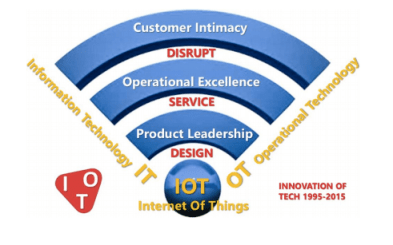techcrunch.com
 }
}
Editor’s note: Jaap Bloem is a principal analyst at VINT (vision, inspiration, navigation, trends), the Capgemini SogetiLabs trend lab, specializing in impact and risk analysis for technology-driven business practices.
Convincing business executives to wisely invest in digital transformation by advocating solutions around cloud, business intelligence, big data analytics, the Internet of Things — or even Everything — has proven to be counterproductive in too many cases. IT-focused people cherish these concepts because we feel that abstraction is needed to stress their vast potential.
But selling promises and proof of concept often only serves to irritate people who, year after year, spent money like water on them.
Wittgenstein to the Rescue
Sure thing that the constant talking of Things and Everything, aka the Internet of Thingamajigs, is driving irritation and suspicion through the roof these days. That’s a shame since such sentiment heavily affects the credibility of valuable digital transformation advice and scenarios.
The right attitude to not making things worse was properly defined by Ludwig Wittgenstein in 1922 when he published his Tractatus in English. Soldier, teacher, engineer, architect and philosopher, Ludwig’s main aspiration was actively being a living no-nonsense icon. Of course nobody pays you to be just a great mind.
The so-called Roaring Twenties and the decade thereafter in many ways together bear a remarkably identical resemblance to our era: technologically, financially, business-wise and socially for instance, against a background of severe international conflict.
Exactly 80 years ago, the February 1935 issue of Everyday Science and Mechanics ranMillions in Gadgets as its cover story. Its message:
Americans spend more than $100,000,000 a year on gadgets made in the U.S. alone, not counting the huge importations from abroad. Here is a field of invention, and unlimited new business possibilities, always open to the ingenious.
Science and Mechanics, February 1935
Need I say more? Just look at the picture and experience this astonishingly striking Internet of Things/Everything analogy avant la lettre: money, volume and disruption all over the place. Of course the big question is how all new gadgets or things will make sense.
Wittgenstein in his Tractatus outlines the answer in a way that was meant to stifle any further discussion, which these carefully selected encompassing news quotes clearly reflect:
- North - The world is the totality of facts, not of things.
- East - The logical picture of the facts is the thought.
- West - Many propositions and questions are not false, but senseless.
- South - We should make clear and delimit sharply the thoughts.
Confronting Fact and Thought
Thus, instead of pitching digital transformation from a grand Internet of Things/Everything vision, overshadowed by cloud and other musings with all potential damage to credibility, in every business case we should start by confronting the contextual web of facts (what actually has been and will be achieved) with the aspired web of thoughts (what we wish to and may be able to achieve). On that basis each time we should have a thorough, sensible and sharp discussion.
Such a common-sense approach seems quite logical when the actual goal is shaping, transforming our world through sensible cyber-physical innovation. It also is a fine example of applying Wittgenstein’s Tractatus Logico-Philosophicus in the down-to-earth demystifying manner it was meant, drawing the picture of the future.
The IOT Tech Triad
 Meanwhile, the transformative capacity of digital tech continues to truly take shape. Over the past 20 years, IT, OT and a fast growing Internet of Things – both product- and customer-oriented – have joined forces and are emerging as a formidable innovation of technology. Through APIs and apps, organizations these days are able to swiftly design disruptive innovations.
Meanwhile, the transformative capacity of digital tech continues to truly take shape. Over the past 20 years, IT, OT and a fast growing Internet of Things – both product- and customer-oriented – have joined forces and are emerging as a formidable innovation of technology. Through APIs and apps, organizations these days are able to swiftly design disruptive innovations.
More and more, business people, product designers, marketeers and CIOs mix and match digital business bricks to increase product quality, service flexibility and customer intimacy. How true this may be and how intelligible it sounds to tech insiders who feel they have come down from their horse, many times the message fails to come across while the IoT tech triad, that was kicked off in 1995 with The Discipline of Market Leaders wrongly remains mistrusted as just another catchy phrase.
That’s why we should take seriously the Wittgensteinian approach to not making things worse.

No comments:
Post a Comment